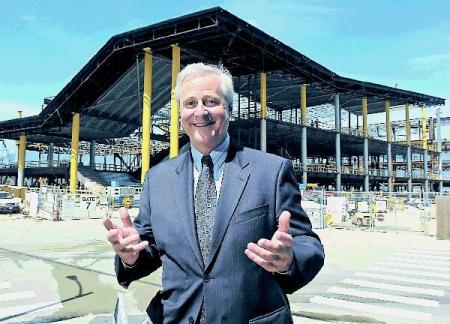Revenues from conventions and U.S. visitors need to jump
Ashley Ford
Province

Rick Antonson stands in front of Vancouver’s new waterfront convention centre, currently under construction. Photograph by : Gerry Kahrmann, The Province
Fears are growing deep within the heart of one of B.C.’s traditionally most optimistic industries.
Representatives of the tourism sector say they are in the fight of their lives to meet the challenge thrown at them earlier this year by Premier Gordon Campbell to double annual tourism revenues to $18 billion by 2015.
“It is going to be one hell of a stretch,” concedes Phil Barnes, regional vice-president of Fairmont Hotels & Resorts.
“You have to remember that rival destinations out there are trying to steal our business.”
Barnes says that while reaching Campbell’s goal isn’t impossible, it will take a monumental joint effort from everyone in the industry — and a whole lot more cash.
“We have to realize that we cannot be all things to all people and must concentrate on the regions that will bring us the highest yields, while not forgetting the rest of the world,” he says.
Tourism Vancouver boss Rick Antonson acknowledges the industry is tiptoeing along a tight line and anticipates there will be some post-2010 Winter Olympics fallout.
To this end, Tourism Vancouver has departed from past practice and produced a new strategic plan and direction from 2008 out to 2015.
The plan, released late last week, boldly states that “by 2015, Vancouver will surpass the previously forecasted $5.8 billion in incremental tourism revenue.” It is now worth about $4.4 billion annually.
Somewhat less boldly, the plan also acknowledges that between next year and 2015 Vancouver will need to attract a higher-yield customer base driven by convention and long-haul leisure business.
And this, Antonson readily acknowledges, is where it gets tricky.
To do this will require a 17-per-cent increase in total spending by Canadian tourists, 20-per-cent growth from the highly lucrative U.S. market and a 59-per-cent jump in the international market.
Breaking it down further, the numbers are equally challenging.
Hitting Campbell’s target will require 52-per-cent growth in convention business, 26 per cent in long-haul leisure revenue, 23-per-cent growth in corporate business, a 14-per-cent jump in independent revenue and seven-per-cent growth in short-haul leisure business.
The U.S. market is causing the most worries as it is already in a downward mode, primarily because of terrorism/border concerns and a fear by Americans of travelling outside their borders.
Throw in the unexpected stratospheric rise of the Canadian dollar and the problems multiply.
And then there is the newly expanding convention centre.
Putting aside the enormous cost overruns, now heading toward the $900-million mark from the original budgeted $495 million, there are real concerns about bookings post-2010.
The convention centre is a linchpin to Tourism Vancouver’s long-term strategy, and the current numbers are not exactly robust, although it is early days.
Former Tourism Vancouver chairman Jim Storie told the organization’s annual meeting last week that the centre has occupancy rates of 38 per cent for 2011, 28 per cent for 2012 and three per cent in 2013.
Just to get to a respectable level from 2010 to 2015 would take the booking of 70 to 80 new conventions by the end of 2009.
Conventions are a huge earner for the city and in 2006 contributed more than $1 billion to the Greater Vancouver economy.
A further critical need is for the sales and marketing structure of the convention centre to be made accountable to the industry for performance, says Antonson.
Currently, responsibility is shared between Tourism Vancouver and the Vancouver Convention & Exhibition Centre, but that must change, Antonson says.
While remaining confident “the centre will be worth every penny that is spent,” he acknowledges that competition from other cities will be tough, even though Vancouver has been named the top destination for international meetings by the International Congress and Convention Association.
Antonson and Vancouver International Airport officials are jetting off to Manchester, England, this week to pitch for an International Routes conference in 2010. This is the group that decides where airlines fly, so it is big, he says.
Even bigger prey is the Alcoholics Anonymous convention, held every five years. Antonson says they are pitching for the 2020 conference, which is the biggest in the world and attracts 65,000 delegates. The decision on a venue will be made next year.
Other critical factors include significant incremental revenues from provincial sources, more hotel rooms and full implementation of the long-promised “open skies” air policy.
The Conservative government continues to sit on its undercarriage despite extolling the virtues and promising “open skies” would be more than a mirage.
Antonson remains confident about the future, even predicting that tourism will ultimately rival forestry as B.C.’s largest industry. But he says his group’s current budget of $12 million is chump change when compared with Montreal’s, $28 million, and Toronto’s, $30 million.
It’s simply not enough to get the job done, he says. Ideally, he would love to put more salespeople into Chicago, Texas, Washington and Europe.
Barbara Maple, president of the Vancouver Convention & Exhibition Centre, says there is absolutely no reason for panic.
“We are exactly on track of where we should be in this booking cycle,” she says. “We have 54 events booked post-2009, and 29 of them would not have come here without the new convention centre because they need that space.”
© The Vancouver Province 2007





